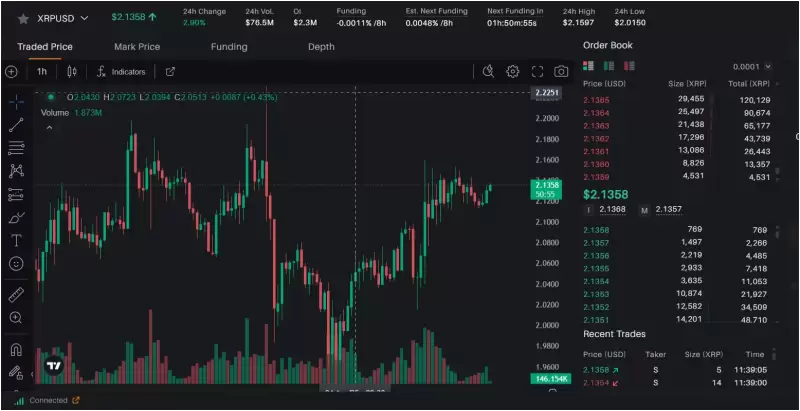 |
|
 |
|
 |
|
 |
|
 |
|
 |
|
 |
|
 |
|
 |
|
 |
|
 |
|
 |
|
 |
|
 |
|
 |
|
Cryptocurrency News Articles
Solving DeFi Fragmentation: Bridging the Gap Between Chains and Users
Mar 26, 2025 at 10:40 pm
As of writing this, the total value locked (TVL) in DeFi has surged to $80.2 billion, nearly doubling from last year's $39 billion.
As Web3 technology rapidly advances, new protocols and applications are continually being developed to enhance the efficiency and accessibility of the digital asset landscape. Among the pressing issues that the industry is actively trying to resolve is the efficient management of liquidity and assets across various chains and protocols.
While cross-chain technology has made transferring assets between blockchains possible, the process can still be complicated for users and developers. Users may find it difficult to navigate different platforms and interfaces to complete simple tasks like swapping tokens or transferring assets. For developers, integrating multiple cross-chain protocols and liquidity sources can be time-consuming and technically challenging.
Moreover, as the number of chains and protocols increases, liquidity becomes increasingly fragmented. This poses a challenge for both users, who may not obtain the best exchange rates or find the desired liquidity on a single platform, and developers, who need to integrate with a greater variety of protocols to provide broader coverage.
To address these challenges and create a more seamless Web3 experience, a startup called LI.FI is introducing a suite of products and services that aim to simplify and streamline multi-chain interactions.
Founded in 2021 by Konstantin Stanislavsky, Ben Maltz, and Michal Pleskot, LI.FI is a startup that focuses on building infrastructure to simplify multi-chain interactions for both users and developers. The startup launched its testing phase in December 2022 and has since raised a total of $70 million to support its development efforts.
LI.FI's core offering is a cross-chain aggregation platform that enables users to seamlessly transfer assets, execute swaps, and interact with various DeFi protocols across multiple chains from a single interface.
The startup's technology combines and processes data from over 18 bridges, 38 decentralized exchanges (DEXs) and DEX aggregators, and 30+ chains to provide users with the best available prices, shortest execution times, and smoothest overall transactions.
In essence, LI.FI acts as a central hub that connects and coordinates liquidity from different sources, allowing users to perform multi-chain actions with ease.
LI.FI is introducing a new level of efficiency and simplicity to the multi-chain experience.
Here's a closer look at how LI.FI is solving critical challenges in the DeFi space:
1. Fragmented Liquidity Across Chains
The increase in the number of chains has seen liquidity become spread across different apps and chains. This makes it harder for users and developers to find the best rates or access the most efficient liquidity. With liquidity being scattered, there’s often higher slippage, suboptimal trading conditions and more manual work to connect to each liquidity source.
To solve this, LI.FI aggregates liquidity from over 30+ chains, 18+ bridges and 38+ DEXs and DEX aggregators into a single platform. Rather than manually navigating fragmented liquidity, users and developers can access everything they need from one place. This means better prices, lower slippage and smoother transactions without having to deal with the complexity of multiple integrations.
2. Complex User Experience in Multi-Chain Transactions
Interacting across chains can be a frustrating experience for users. Swapping, bridging or moving assets typically requires multiple steps and different tools, which makes the process slow and confusing. This complexity discourages users from engaging fully with DeFi.
Zaps, a feature in our stack, streamline the process by bundling multi-step transactions into one action, whether it’s swapping, bridging or staking. We handle the complicated processes behind the scenes, which simplifies multi-chain actions. Through a single API call, users can perform cross-chain swaps, transfers and directly interact with your app, without needing to worry about the underlying steps to get there.
This drastically improves the overall experience by reducing the effort and knowledge required to interact with DeFi.
3. Developer Complexity in Integrating Multi-Chain Features
For developers, adding multi-chain functionality is a challenge. They need to intergrate multiple bridges, liquidity sources and protocols, which increases both development time and maintenance costs. This slows down the ability to launch new features or support different chains.
With access to a single integration point, developers no longer have to deal with the headache of piecing together different systems.
LI.FI offers a range of tools that are available depending on how much control and customisation you require:
• APIs and SDKs offer deeper customisation, allowing developers to build cross-chain swaps, bridges and liquidity features in a way that best fits their specific application. These tools provide full control, enabling developers to intergrate features with precision while managing gas fees, optimising routes and minimalising slippage.
• For developers who prefer a quicker solution, Widgets provide a plug-and-play option. With just a few lines of code, developers can integrate multi-chain functionality instantly. This approach is perfect for those who need rapid deployment without the
Disclaimer:info@kdj.com
The information provided is not trading advice. kdj.com does not assume any responsibility for any investments made based on the information provided in this article. Cryptocurrencies are highly volatile and it is highly recommended that you invest with caution after thorough research!
If you believe that the content used on this website infringes your copyright, please contact us immediately (info@kdj.com) and we will delete it promptly.
-

-

- Project Eleven Launches Q-Day Prize, Offering 1 BTC to the First Team to Break Bitcoin's Cryptography Using a Quantum Computer
- Apr 17, 2025 at 05:55 pm
- Project Eleven, a quantum computing research and advocacy firm, has launched the Q-Day Prize, a global competition offering 1 bitcoin (BTC) to the first team able to break an elliptic curve cryptographic (ECC) key, the cryptography which secures the Bitcoin network, using Shor’s algorithm
-

-

-

-

-

-

-





























































